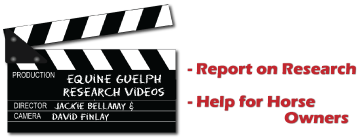2007-2008 Projects
Role of the embryonic capsule in the success of early pregnancy
Dr. K. Betteridge
Stem cell therapy to treat cartilage defects and injuries in horses
Dr. D. Betts
Clara cell secretory protein in equine recurrent airway obstruction
Dr. D. Bienzle
Evaluation of the survival of Streptococcus equi on environmental surfaces under normal outdoor conditions
Dr. S. Weese
Streptococcus equi is the cause of strangles, a common and often highly frustrating disease, which can occur both sporadically and in outbreaks. Management of affected animals and their environment can be problematic, both because of the nature of the pathogen and because of the lack of important information in key areas. Direct contact with infected or colonized horses is believed to be the main sources of infection, but these horses can shed large numbers of S. equi in nasal discharge or pus, and this raises concerns about the role of the farm environment in disease transmission. The proposed study will evaluate S. equi survival on fencing and feed container surfaces under normal outdoor environmental conditions and will provide appropriate infection control protocols.
Clinical signs and mechanisms of airway inflammation of equine rhinitis A virus in experimentally infected horses
Dr. L. Viel
Recently a 2 1/2 year study on the prevalence of Equine Influenza Virus, Rhinovirus and Herpes Virus in respiratory outbreaks of yearlings and young racing horses in Ontario was completed. Of interest, all horses positive for Influenza virus were also positive for rhinovirus-1. Until now, rhinovirus had been considered to play an insignificant role in the complex of respiratory viral infections. As a result, little is known about its clinical manifestation and effects on the respiratory airway passages. The present work will undertake a systematic study on how the virus infects the airways, the short and long term consequence of the infections and ultimately the introduction of this virus in commercially available vaccine products.
Analysis of cardiac ion channels in horses with lone atrial fibrillation
Dr. B. Hanna
Ion channels are transmembrane proteins that produce electric signals in excitable tissues such as nerve, heart and skeletal muscle. Some humans with lone atrial fibrillation have dysfunctional cardiac ion channels that interfere with signal conduction in the atria. The purpose of the present study is to examine cardiac ion channel structure and function in horses with lone atrial fibrillation, in an effort to identify the cause of the disorder. This work may lead to improved diagnostic tests for the disorder.
Evaluation of a commercially available immunoassay for the diagnosis of Clostridium difficile-associated diarrhea in horses
Dr. H. Staempfli
Clostridium difficile has been implicated as a causative agent in equine diarrhea and thus, as an enteric pathogen in adult horses. Acute diarrhea in the horse is often fatal, has been associated with important morbidity, and therefore is a cause of important economic losses. The initiating cause of diarrhea in horses remains often undiagnosed. The proposed study will evaluate the performance of a commercially available immunoassay test (TechLab© C. difficile Tox A/B II Immunoassay (EIA) kit) and determine the sensitivity and specificity of this test for rapid diagnosis of C. difficile in horses.
Study of the pathogenesis of arterial calcification in horses and its potential clinical implications
Dr. L. Viel
The Ontario Racing Commission created the Death Registry Program in order to investigate the causes of death or reasons for euthanasia in racing horses. Using a standardized pathology examination protocol for the cardiovascular system, vascular lesions were found in arteries such as the aorta and pulmonary vessels in approximately 30% of those horses. The cause of death appears to be the result of vascular wall rupture leading to massive haemorrhage. The objective of this study is to determine the prevalence, causes and pathogenesis process involved in vascular degeneration of large arteries in racing horses.
Oral vaccination of foals using a mutant strain of Rhodococcus equi 103
Dr. J. Prescott
Rhodococcus equi, is a major pathogen of foals aged 1 to 6 months that causes abscesses in the lung. Current prophylaxis against infection, including administration of hyperimmune plasma against R. equi and environmental management, is only partially effective. Therefore, additional protection by vaccination is needed to further decrease the incidence of this disease. Previous efforts to produce an effective R. equi vaccine have been thus far unsuccessful. The present study will attempt to develop a vaccine using a new strategy through mutating genes of a killed but metabolically active bacteria.
Non-invasive surveillance of cannon bone and joint health in racehorses by quantitative ultrasound and biomarkers
Dr. A. Cruz
This project is part of a larger ongoing program to identify and prevent catastrophic bone failure and musculoskeletal wastage in thoroughbred racehorses. The project will investigate and monitor the cannon bones and joint health of 2 and 3 year old racehorses and will determine their response to exercise. In the last two years we have identified from post-mortem specimens (death registry program) quantitative ultrasound locations in the cannon bone of racehorses that could predict bone failure and abnormal remodelling. Our findings showed severe joint diseases of over 70% associated with subchondral bone disease in the fetlock joint. The present study will use the techniques and knowledge acquired from the previous study and evaluate the cannon bones of thirty-two 2 and 3 year-olds racehorses on a monthly basis during the racing season for two consecutive years.
